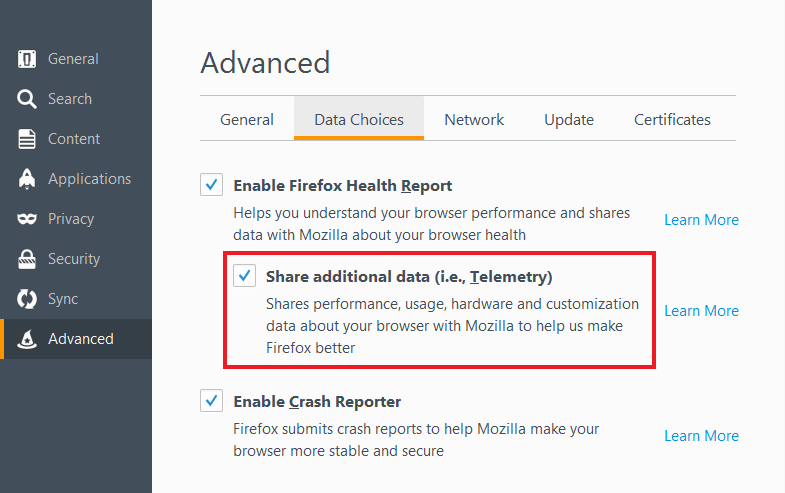Mozilla has released statistics on hardware on client PCs.

If you are a web developer, you need to know what hardware your application will run on. Maybe it won't start at all. What screen resolution should optimize the layout and illustrations for? What are the processors, operating systems, how much memory is installed on users' computers. Answers to all these questions are provided by a fresh Firefox Hardware Report , compiled from telemetry from computers running Firefox.
Such reports are sometimes published in the public domain. For example, they are published by Valve and Unity , but there is still presented a rather specific slice of the audience - gamers. Mozilla statistics provide a much more objective picture of what ordinary people work on. Most Internet users.
Mozilla developers write that they are concerned about the analysis of these statistics in connection with the creation of the next-generation gaming web platform , on which they have been working for several years. From game developers often come questions - what equipment to navigate, what are the ordinary users. The results of statistical research allow us to draw certain conclusions and make the right decisions.
')
In most statistical sections, more detailed data is available for viewing under the link "More details". All statistics are collected from users of the desktop version of the Firefox browser via telemetry .
Screen resolution
First look at the screen resolution. The most popular resolution for a long time remains 1366 × 768 pixels, with a large margin from all other resolutions. Today, 32.54% of computers work with this resolution.
In the second place is 1920 × 1080 (17.90%).
The rest of the permissions share less than 9%.
Mozilla statistics are collected from March 2016. During this time, the share of computers with a resolution of 1366 × 768 pixels remained unchanged (it was 32.43%), and the share of 1920 × 1080 increased from 16.87% to 17.90%.
operating system
There are also two clear leaders here: Windows 7 (44.86%) and Windows 10 (25.67%). Two thirds of users work on 64-bit OS (67,73%), the rest - on 32-bit.
Interestingly, in the past three months, the share of Windows 7 has ceased to decline, and the share of Windows 10 has ceased to grow. Probably, the termination of Microsoft marketing actions, which pushed users to upgrade, had an effect. By their will, they are not ready to do this.

“Apple” Darwin of different versions takes 3.38%, 2.08% and 1.19%.
Linux distributions are probably hidden in the “Others” category, which is 0.18%. Perhaps this result is due to some kind of measurement error or a representative sample.
Firefox collects telemetry from users by default and sends it to Mozilla on a daily basis, unless users disable this feature .

Perhaps Linux users are much more literate than the average Firefox audience. And they massively turned off telemetry data collection. Or in the Linux version some glitch and telemetry is missing . UPD: in the comments, it was explained that the Linux maintainers of the distributions disable this feature or completely cut out these code fragments, since Linux tracking users is not encouraged.

Graphics
More than half of the computers have Intel's main integrated graphics (62.58%). The second and third lines are shared by AMD (17.79%) and Nvidia (16.43%).
Among the GPU models, the positive dynamics is demonstrated by the graphics built into Haswell, Broadwell and Skylake. Sandy Bridge (GT2) share is declining. The rest practically did not change their positions in half a year.
CPU
A quarter of users work on computers with a processor clock speed of 2.3 to 2.69 GHz (26.41%). The remaining categories are lagging behind quite significantly:
From 2.0 to 2.29 GHz - 16.44%
From 3.0 to 3.29 GHz - 14.02%
From 2.7 to 2.99 GHz - 12.59%
from 3.3 to 3.69 GHz - 10.55%
From 1.7 to 1.99 GHz - 9.73%
1.5 to 1.69 GHz - 5.17%
The rest of the share less than 1.24%.
More than two-thirds of computers work with a dual-core processor (69.24%). Other options are much smaller. For example, quad-core 22.08%, single-core - 7.18%. the rest - 1.5%. All these indicators have not changed for half a year.
Memory
Every third user has 4 GB of RAM installed, the share of such users is slowly increasing (30.21%). In second place are users with 2 GB of memory, their share is slowly decreasing (18.74%).
Flush
The availability of the Flash plugin for the Firefox browser demonstrates a downward trend. For six months, it decreased from 82.19% to 76.86%. The share decreases slowly, so the flash still remains a common platform for games and other applications.
Average user
So, the average configuration of a computer on the Internet today looks like this:
Operating system: Windows 7
Screen Resolution: 1366 × 768
Dual Core Processor
Integrated graphics card
4 GB RAM or less
It seems that most people just do not need an upgrade.
Source: https://habr.com/ru/post/372979/
All Articles